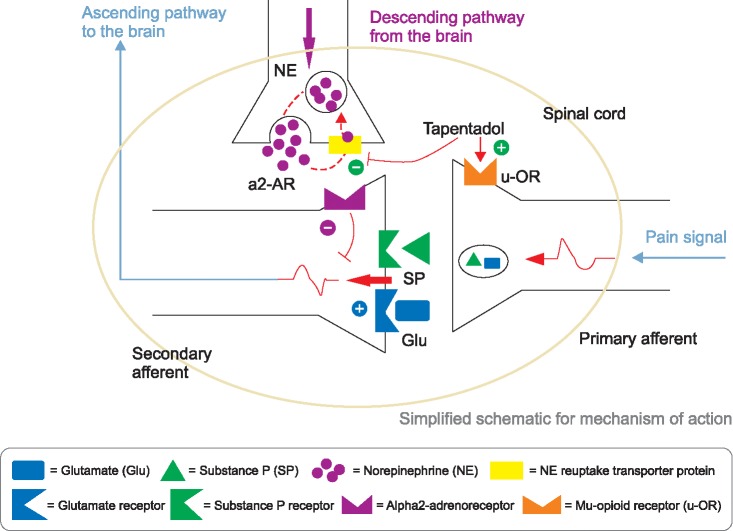1. Lassen D, Damkier P, Brøsen K. The pharmacogenetics of tramadol. Clin Pharmacokinet. 2015; 54:825–836. PMID:
25910878.

2. Farquhar-Smith P, Gubbay A. Tramadol and acetaminophen combination for chronic non-cancer pain. Expert Opin Pharmacother. 2013; 14:2297–2304. PMID:
24067074.

3. Kress HG. Tapentadol and its two mechanisms of action: is there a new pharmacological class of centrally-acting analgesics on the horizon? Eur J Pain. 2010; 14:781–783. PMID:
20659810.

4. Dart RC, Bartelson BB, Adams EH. Nonmedical use of tapentadol immediate release by college students. Clin J Pain. 2014; 30:685–692. PMID:
24042351.

5. Dart RC, Cicero TJ, Surratt HL, Rosenblum A, Bartelson BB, Adams EH. Assessment of the abuse of tapentadol immediate release: the first 24 months. J Opioid Manag. 2012; 8:395–402. PMID:
23264317.

6. Buschmann H. Chapter 12 Tapentadol – from morphine and tramadol to the discovery of tapentadol. In : Fischer J, Ganellin CR, Rotella DP, editors. Analogue-based drug discovery III. Weinheim: Wiley-VCH;2013. p. 295–318.
7. Wade WE, Spruill WJ. Tapentadol hydrochloride: a centrally acting oral analgesic. Clin Ther. 2009; 31:2804–2818. PMID:
20110020.

8. Smyth LA, Collins I. Measuring and interpreting the selectivity of protein kinase inhibitors. J Chem Biol. 2009; 2:131–151. PMID:
19568781.

9. Tzschentke TM, Folgering JH, Flik G, De Vry J. Tapentadol increases levels of noradrenaline in the rat spinal cord as measured by in vivo microdialysis. Neurosci Lett. 2012; 507:151–155. PMID:
22197547.

10. Ramaswamy S, Chang S, Mehta V. Tapentadol--the evidence so far. Anaesthesia. 2015; 70:518–522. PMID:
25866038.
11. Ok YM, Cheon JH, Choi EJ, Chang EJ, Lee HM, Kim KH. Nefopam reduces dysesthesia after percutaneous endoscopic lumbar discectomy. Korean J Pain. 2016; 29:40–47. PMID:
26839670.

12. Kim KH, Abdi S. Rediscovery of nefopam for the treatment of neuropathic pain. Korean J Pain. 2014; 27:103–111. PMID:
24748937.

13. Barber J. Examining the use of tramadol hydrochloride as an antidepressant. Exp Clin Psychopharmacol. 2011; 19:123–130. PMID:
21463069.

14. Terlinden R, Ossig J, Fliegert F, Lange C, Göhler K. Absorption, metabolism, and excretion of 14C-labeled tapentadol HCl in healthy male subjects. Eur J Drug Metab Pharmacokinet. 2007; 32:163–169. PMID:
18062408.

15. Singh DR, Nag K, Shetti AN, Krishnaveni N. Tapentadol hydrochloride: a novel analgesic. Saudi J Anaesth. 2013; 7:322–326. PMID:
24015138.

16. Park CH. Comparison of morphine and tramadol in transforaminal epidural injections for lumbar radicular pain. Korean J Pain. 2013; 26:265–269. PMID:
23862000.

17. Xu XS, Smit JW, Lin R, Stuyckens K, Terlinden R, Nandy P. Population pharmacokinetics of tapentadol immediate release (IR) in healthy subjects and patients with moderate or severe pain. Clin Pharmacokinet. 2010; 49:671–682. PMID:
20818833.

18. Afilalo M, Etropolski MS, Kuperwasser B, Kelly K, Okamoto A, Van Hove I, et al. Efficacy and safety of Tapentadol extended release compared with oxycodone controlled release for the management of moderate to severe chronic pain related to osteoarthritis of the knee: a randomized, double-blind, placebo- and active-controlled phase III study. Clin Drug Investig. 2010; 30:489–505.

19. Cepeda MS, Fife D, Ma Q, Ryan PB. Comparison of the risks of opioid abuse or dependence between tapentadol and oxycodone: results from a cohort study. J Pain. 2013; 14:1227–1241. PMID:
23850177.

20. Cepeda MS, Fife D, Vo L, Mastrogiovanni G, Yuan Y. Comparison of opioid doctor shopping for tapentadol and oxycodone: a cohort study. J Pain. 2013; 14:158–164. PMID:
23253635.

21. Dart RC, Surratt HL, Le Lait MC, Stivers Y, Bebarta VS, Freifeld CC, et al. Diversion and illicit sale of extended release tapentadol in the United States. Pain Med. 2015; pii: pnv032. Forthcoming.

22. Butler SF, McNaughton EC, Black RA. Tapentadol abuse potential: a postmarketing evaluation using a sample of individuals evaluated for substance abuse treatment. Pain Med. 2015; 16:119–130. PMID:
25243972.

23. McNaughton EC, Black RA, Weber SE, Butler SF. Assessing abuse potential of new analgesic medications following market release: an evaluation of internet discussion of tapentadol abuse. Pain Med. 2015; 16:131–140. PMID:
25244069.

24. Vosburg SK, Jones JD, Manubay JM, Ashworth JB, Shapiro DY, Comer SD. A comparison among tapentadol tamperresistant formulations (TRF) and OxyContin® (non-TRF) in prescription opioid abusers. Addiction. 2013; 108:1095–1106. PMID:
23316699.






 PDF
PDF Citation
Citation Print
Print





 XML Download
XML Download